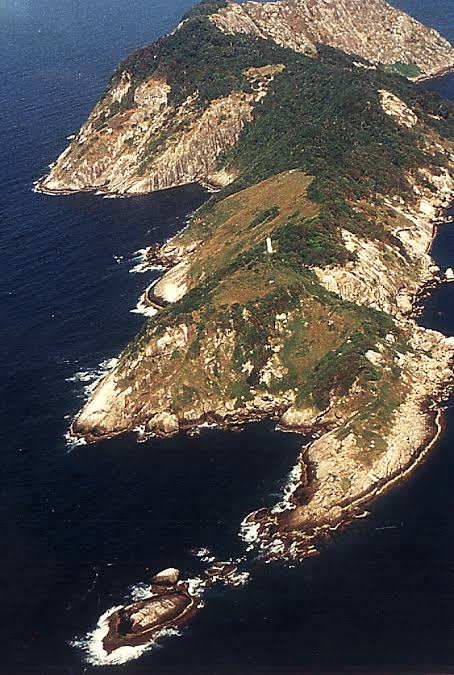The Island of Snakes

Island of Snakes
Ilha da Queimada Grande is a small island in the Itanhaem in state of Sao Paulo, Located on the coast of Brazil (South America). This island is also called the island of snakes. It is a small island with dense forests and hard barren cliffs.
With a moderate climate, the island is home to endangered venomous snakes, the golden lancehead pit viper Snake (Bothtrops Insularis). In the past, rising sea levels have engulfed the land adjacent to the island, leaving snakes trapped on the island.
The snakes on the island adopted this change and began to increase their population. Due to the growing population of venomous snakes, the island was declared unsafe for humans. Here you will find one snake per square meter. That's why access to the island was restricted to the Brazilian Navy and related experts to protect human lives and the snake population.
Golden Lancehead Pit Viper
These snakes are golden in color.
About 28 to 46 inches long, these snakes are found in holes, in rocks, layers of gray leaves on the ground, and sometimes on trees.
Unlike other snakes of its genus, it has been named the Viper Snake because of its different head texture.
Due to the large number of snakes and limited resources, these snakes face food problems. Although there are 41 species of birds on the island, these snakes rely on only two types.
1. The Southern House wren
2. Specie of Flycatcher
According to an estimate in 2015, the number of these snakes on the island has gradually decreased.
One of the most venomous species of viper snakes is the Lancehead Viper snake found in Brazil.
Human Deaths
Despite being highly venomous, the golden lancehead pit viper has a very low rate of attack on humans. The main reason is the nature of these snakes to stay away from the human population.
In contrast, all other lance heads, except the golden lancehead pit viper, are responsible for the most deaths in South America and North America.
Venom
According to an analysis, the golden golden lancehead pit viper snake has a venom 5% more deadly than all other snakes. They contain a special type of neurotoxic toxin that helps kill prey.
If this snake bites a human, the body begins to rot and the flesh separates from the bones, due to lack of timely treatment, death can occur in 1 hour.
Food
Although most of these snakes depend on birds for food, lizards are also part of their diet.
Breeding
The breeding season is August to September. Unlike other snakes, they lay snake-let instead of eggs.
Risks
Recently this golden lancehead pit viper snake Has been added to the IUCN and Brazilian Endangered Species List. The main reason for the extinction of these snakes is the destruction of snake habitats by cutting and burning for farming in the past.
Venom and Pharmaceuticals
Although snake venom is considered deadly to human lives, the venom of the golden lancehead pit viper snake also acts as a medicine for many diseases.
Marcelo Duarte, a scientist at the Brazilian Botany Institute,
Have worked on the importance of the poison Of Snakes. He said tha venom has been shown to be helpful in blood circulation, heart disease and blood clots.
Human hatred of snakes and other human activities are destroying rare types of snakes, such as the golden lancehead pit viper are on the verge of extinction.
Now more about this island
Geography
Covering an area of 430,000 square meters (110 acres), the island is located 33 kilometers (21 miles) off the coast of the Brazilian state of Sao Paulo. About 0.25 sq km of the island is covered with dense forests.
Height:
The island is located at an average altitude of 206 meters (676 feet) above sea level.
Climate
Like its neighboring island of Nimr, it has a moderate climate.
Average Rainfall
0.2 mm on the island in the month of July
(0.0079 inches) while 135.2 mm in December
(5.32 inches) of rain has been recorded.
Temperature
Temperatures reach 27.28 degrees Celsius in March and 18.38 degrees Celsius in August.
History
One Part of the island is covered with forests while the rest has turned into rocks after deforestation. The locals burned down the forest, after that People named that area, Kiumada (Portuguese word meaning "burn").
The Brazilian Navy built an independent lighthouse on the island in 1909.
This island of snakes is uninhabited but humans have been staying here for a short time.
Humans ceased to live here in the late 1920s. The reason for this is that according to the stories, snakes had entered through the windows of the lighthouse and killed the lighthouse keeper and his family. Nowadays, the Navy regularly visits the lighthouse so that no one is accidentally stranded on the island. There is another famous story about the presence of snakes on the island, according to which these snakes were left on the island by the pirates, so that no one could find their treasure buried here.
In fact, the reason for the snakes on this island is the rising sea level. The island was part of Brazil 10,000 years ago. After that, when the sea level rose, it separated from the central part of Brazil and became an island. The snakes of the island satisfy their hunger by eating the birds that come here. Many people go to this island illegally and catch these snakes and risk their lives. The venom of this snake is very expensive to sell, so those who go here illegally do not even care about their lives.

 My First News Item
My First News Item My Nine News Item
My Nine News Item